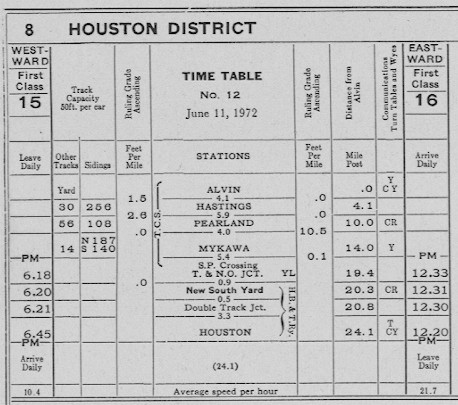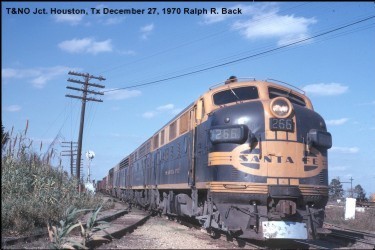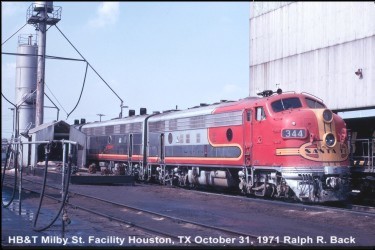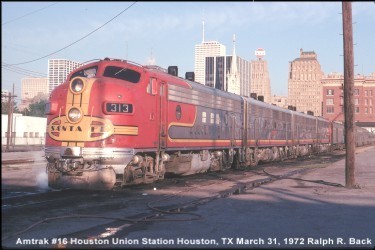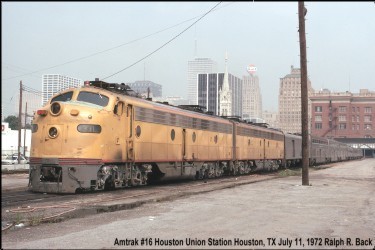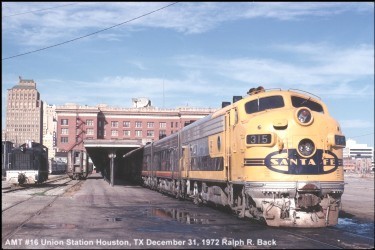Material Provided by Ralph Back |
|
Santa Feís Southern Division Houston District 1970 - 1973 Article and photography by Ralph R. Back OPERATIONS Santa Feís Western Lines Southern Division mainline handled all freight and passenger traffic between Cleburne, Texas and the Houston - Galveston area. This division was divided into four main districts to handle the traffic: the First District covered Cleburne to Temple, the Second District covered Temple to Bellville, the Third District covered Bellville to Galveston, while the Houston District covered Houston to Alvin the junction with the Third District.
The Houston District timetable from Southern Division Timetable No. 12 In Effect Sunday, June 11, 1972. ATSF trackage on the Houston District actually began at T&NO Junction at the south end of Houston Belt & Terminal Railwayís (HB&T) New South Yard and continued south through Pearland and on to Alvin where it joined the Third District. The Houston District carried all freight and passenger traffic in and out of the Houston area. Excluding the HB&T trackage, the Houston District covered only about 20 miles.
ATSF F7 266L is just departing the HB&T New South Yard passing T&NO Jct. and entering the ATSF trackage of the Houston District. The track going off to the left enters the SP line to Rosenberg Tower 17. During the early 1970s, the Southern Division was one of the last strongholds for Santa Feís F-unit fleet. The majority of freight traffic was handled by solid lash-ups of 200 and 281 class F7s and F9s in the standard blue/yellow freight livery. Occasionally, GP7s and GP9s were seen in lashups with the Fs. The Southern Division also hosted a daily Houston-Chicago passenger train the Texas Chief, train numbers 15 and 16, which was powered by red/silver Warbonnet F-units. Second generation power was also seen here: GP20s, GP38s, U25Bs, U33Cs, U23Bs, SD45s, SD24s, SD26s and RSD15s. ATSF freight power was serviced by the HB&T at its Milby Street facility which was located about one mile southeast of Houstonís Union Station. The HB&T provided terminal and switching services in the Houston area for the Santa Fe, BN, and Rock Island. Units from the BN and Rock Island were also serviced here. The HB&T rostered a fleet of SW9s, SW1200s, SW1000s, and SW1500s.
ATSF 344L is sitting at the HB&T Milby St. facility. HB&T services the ATSF freight power here. A turntable is available for turning one locomotive at a time. THE TEXAS CHIEF The Texas Chief operated over the Southern Division during daylight hours. Departure time from Houstonís Union Station for eastward #16 was 7:20 a.m. The departure time for eastward #16 changed in June, 1972 to 12:20 p.m. Upon its arrival at Houston, the westward train #15 backed into Union Station. The train and power remained at Union Station becoming eastward train #16 the next day. The arrival time for westward #15 was 8:30 p.m. until June, 1972 when the arrival time was changed to 6:45 p.m.
ATSF #16 is just departing Houston Union Station at 7:20 a.m. To arrive and depart Houstonís Union Station the Texas Chief, traveled over HB&T trackage between Southern Pacificís T&NO junction (at the south end of HB&Tís New South Yard) and Union Station for a distance of about 5 miles. By Santa Feís Southern Division timetables for this period train #15 was westward and #16 was eastward, and this trackage was part of the Houston District where Santa Fe trains were governed by HB&T timetables, rules, and regulations. The Texas Chief did not go to Alvin as the trackage from T&NO Junction to Alvin and from Alvin to Rosenberg was freight only which was the Santa Fe mainline in and out of Houston and south Texas. Instead the Texas Chief used Southern Pacific trackage between SPís T&NO Junction and SPís Tower 17 in Rosenberg, and joined the Santa Fe Third District at Rosenberg.
Amtrak #16 with ATSF F7 313L has its head light on and is ready to depart Houston Union Station. MOTIVE POWER ASSIGNMENT Significant changes occurred in the Santa Fe motive power assigned to the Texas Chief. Prior to Amtrak, power assignment for the Texas Chief was usually four 325 class F7s in ABBA, ABAB, or ABBB lashups. After Amtrak took over on May 1, 1971, the power assignment was changed to 300 class F3s and F7s in the same lashups. The 300 class was leased to Amtrak and consisted of the remaining members of the original 300 class along with 16 class F3s and 37 class F7s renumbered into the 300 class. The 325 class was assigned to freight service, and the 300 class was assigned to Amtrak service. The 300 class was assigned exclusively until May 1972 when ex-Union Pacific E-units were placed in service on the Texas Chief. The assignment of the UP Es lasted only about four months.
Amtrak #16 with ex-UP E-units is at Houston Union Station waiting for itís 12:20 p.m. departure. The return of F-unit assignment to the Texas Chief brought one new change, the yellow-bonnet paint scheme. The Santa Fe painted two of the 300 class F7s (304L and 315L) in this new scheme. The 315L was assigned exclusively to the Texas Chief and could be found frequently as the lead unit. In July 1973 the new Amtrak SDP40Fs were delivered and assigned to the Texas Chief thus ending the Santa Fe Warbonnet era on the Texas Chief passenger trains.
Amtrak #16 with ATSF 315L at Houston Union Station awaits itís 12:20 p.m. departure time. |








